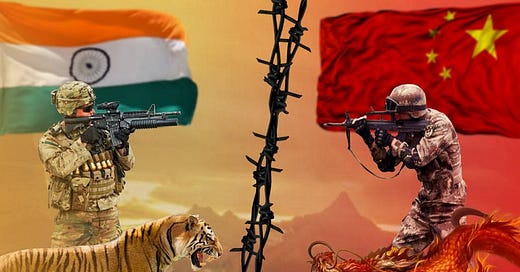Sino-Indo Relations Have Recently Hit A Rough Patch
Those in the Alt-Media Community who peddle the disinformation narrative implying that China and India are united against the West (irrespective of whether they hint that it’s opposing that bloc via bilateral efforts or through BRICS) are either ill-informed of the objectively existing and easily verifiable facts about the latest rough patch in their relations or are deliberately misleading their targeted audience in pursuit of clout, ideology, and/or soliciting donations from them.
The Alt-Media Community’s (AMC) leading influencers have a tendency to misportray Global South states as supposedly being on the same page in all respects and united in opposition to the West, but this notion is disproven by the top two such countries recently hitting a rough path in their relations. Sino-Indo ties have worsened over the past week as a result of China’s latest renaming of Indian-controlled disputed territory and the seemingly tit-for-tat visa issues with each other’s journalists.
The Chinese Foreign Ministry spokeswoman’s perfunctory policy reaffirmation regarding her country’s desire to trilaterally cooperate with Russia and India, which was prompted by a journalist asking her a question about the relevant part of Moscow’s new foreign policy concept, doesn’t change this reality. The present state of Sino-Indo affairs discredits the AMC’s previously mentioned narrative and also bodes ill for its members’ high hopes about BRICS’ new reserve currency project.
These two still pursue multipolar grand strategies and have shared interests in financial multipolarity, but it’s unlikely that either will feel comfortable going all-in when it comes to backing the aforementioned currency, which some reports suggest might be a commodities-backed digital one. It’ll probably end up being unveiled at some point, irrespective of whether it’s during the next BRICS Summit this summer, but both China and India will likely continue prioritizing their own national currencies.
The first is predicted to pursue its unofficial “petroyuan” project following its successful mediation of the Iranian-Saudi rapprochement while the second will double down on internationalizing the rupee per its newly unveiled Foreign Trade Policy. This trajectory isn’t expected to change unless there’s a breakthrough in resolving their long-running border dispute, which remains bilateral despite the US’ attempted meddling, but that requires one or both of them to compromise on their strict positions.
Since that’s unlikely to occur, observers shouldn’t get their hopes up about the AMC’s wishful thinking narrative ever transpiring wherein the world’s largest Global South states unite against the West. Those who encourage others to expect this scenario in the coming future are either ill-informed of the objectively existing and easily verifiable facts shared thus far in this analysis or are deliberately misleading their targeted audience in pursuit of clout, ideology, and/or soliciting donations from them.
That said, while the latest rough patch in Sino-Indo relations is undoubtedly concerning, there’s also no reason for anyone to overreact to it by predicting a large-scale conventional war between them. Their respective leaderships are doing their best to responsibly manage these tensions, which their shared Russian strategic partner also has an interest in doing as well upon their request, so speculation about an impending apocalyptic conflict is nothing but fearmongering.
The most likely course of events is that the trifurcation of International Relations into the US-led West’s Golden Billion, the Sino-Russo Entente, and the informally Indian-led Global South will accelerate, with the Sino-Indo faultline between the last two hardening but nevertheless remaining manageable. Their shared Russian strategic partner will diplomatically intervene in the event of any unexpected crisis, thus thwarting whatever plans the US has to exploit their border dispute in order to divide-and-rule them.
The Kremlin won’t be able to successfully mediate a rapprochement between them along the lines of China’s Iranian-Saudi one, however, because neither party has requested its attendant diplomatic intervention nor do they have any interest in making the politically difficult compromises required. Each is therefore expected to toughen their policy against their other in all respects but will probably remain careful not to cross informal red lines along the border that could risk inadvertently provoking a conflict.
Their complementary but uncoordinated de-dollarization policies related to the yuan and rupee will accelerate financial multipolarity, as would any tangible cooperation on BRICS’ new reserve currency project, but nobody should imagine that these BRICS and SCO partners are anti-Western allies. They’re engaged in a fierce border dispute, will probably escalate information operations against the other in the coming future, and are actively competing for hearts and minds across the Global South.
The latest rough patch in Sino-Indo relations is therefore indicative of the “new normal” in their ties that’s expected to last throughout the decade. This faultline in the emerging Multipolar World Order can’t be denied by any honest observers, thus discrediting those in the AMC who continue implying that those two don’t have any serious problems between them and are united against the West. That’s factually false as was explained, and those who fall for this disinformation are bound to be disappointed.




